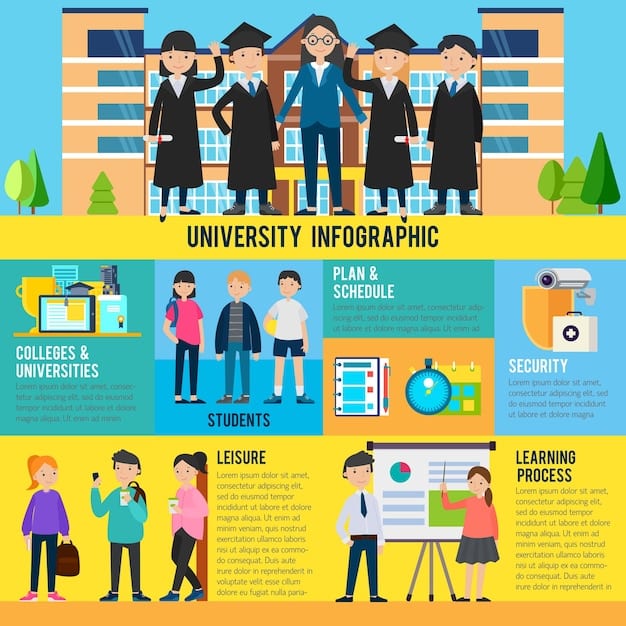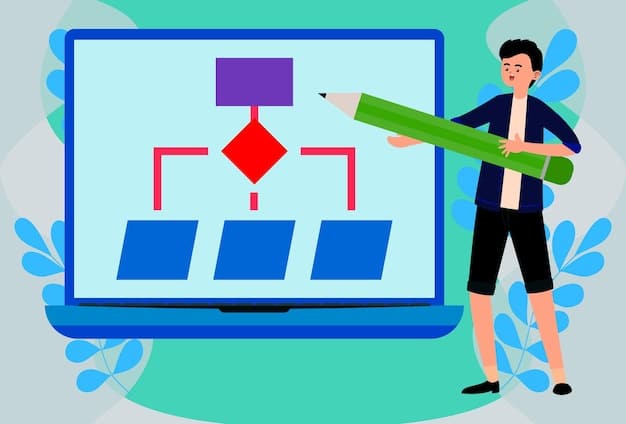Navigating Student Loan Forgiveness Programs: A 2025 Guide

Navigating Student Loan Forgiveness Programs in 2025 can seem daunting, but understanding eligibility requirements, application processes, and available options like Income-Driven Repayment plans and Public Service Loan Forgiveness is crucial for borrowers seeking financial relief and a debt-free future.
Are you overwhelmed by student loan debt? Navigating Student Loan Forgiveness Programs: A Comprehensive Guide to Eligibility and Application in 2025 provides clarity and actionable steps to help you pursue a debt-free future.
Understanding Student Loan Forgiveness Programs
Student loan forgiveness programs offer eligible borrowers a pathway to have their federal student loan debt partially or fully forgiven. These programs are designed to assist individuals working in specific professions or those meeting certain income requirements. Understanding the different types of programs is the first step in determining if you qualify.
Federal Student Loan Forgiveness: An Overview
Federal student loan forgiveness programs are primarily offered by the U.S. Department of Education. These programs aim to alleviate the burden of student loan debt for individuals who have dedicated their careers to public service, teaching, or other qualifying professions. Programs such as Public Service Loan Forgiveness (PSLF) and Income-Driven Repayment (IDR) forgiveness offer distinct eligibility criteria and benefits.
State-Sponsored Loan Forgiveness Programs
In addition to federal programs, some states offer their own loan forgiveness initiatives. These programs often target specific professions in high-need areas, such as healthcare workers in rural communities or teachers in underserved schools. State programs can provide additional opportunities for forgiveness, complementing federal options.

Here are some key aspects to consider when exploring student loan forgiveness programs:
- Eligibility Requirements: Each program has specific criteria that borrowers must meet, such as employment in a qualifying public service job or adherence to income-driven repayment plans.
- Application Process: The application process involves submitting detailed documentation, including employment certifications and income verification.
- Tax Implications: Some forgiveness programs may have tax implications, where the forgiven amount is considered taxable income. It’s essential to understand these implications and plan accordingly.
Navigating student loan forgiveness programs requires careful research and attention to detail. By understanding the different options available and their respective requirements, borrowers can make informed decisions and pursue the path that best aligns with their financial goals.
Eligibility Criteria for Loan Forgiveness
Each student loan forgiveness program comes with its own set of eligibility criteria. These criteria typically relate to the type of loan, the borrower’s employment, and the repayment plan they are enrolled in. Careful evaluation of these factors is crucial to determine if you meet the necessary qualifications.
Qualifying Loans for Forgiveness
Not all student loans are eligible for every forgiveness program. Generally, federal Direct Loans are eligible for most programs, including PSLF and IDR forgiveness. However, other types of federal loans, such as Federal Family Education Loan (FFEL) Program loans and Perkins Loans, may require consolidation into a Direct Loan to become eligible.
Employment Requirements for PSLF
The Public Service Loan Forgiveness (PSLF) program requires borrowers to be employed full-time by a qualifying employer, which includes government organizations (federal, state, local, or tribal) and certain non-profit organizations. The type of job is not a factor, as long as the employer qualifies.
To qualify for PSLF, you must also:
- Make 120 qualifying monthly payments under a qualifying repayment plan.
- Be employed full-time by a qualifying employer at the time of application.
- Have Direct Loans or consolidate other federal student loans into a Direct Consolidation Loan.
Income-Driven Repayment (IDR) Plan Eligibility
Income-Driven Repayment (IDR) plans offer loan forgiveness after a specified repayment period, typically 20 or 25 years, depending on the plan. Eligibility for IDR plans is based on the borrower’s income and family size. These plans are designed to make monthly payments more affordable by adjusting them based on the borrower’s discretionary income.
Checking your eligibility for loan forgiveness programs involves evaluating your loan types, employment situation, and repayment plan. Ensuring that you meet all the necessary criteria is essential for a successful application.
Application Process: Step-by-Step Guide
The application process for student loan forgiveness programs can be complex, but following a step-by-step guide can help you navigate it successfully. Gathering the necessary documentation, completing the application accurately, and submitting it on time are crucial for a smooth process.
Gathering Necessary Documentation
Before starting the application, gather all required documentation, including:
- Loan Documents: Information about your federal student loans, such as loan types, outstanding balances, and repayment history.
- Employment Certification: For PSLF, you’ll need to provide documentation from your employer confirming your qualifying employment. The PSLF Help Tool can assist in preparing this form.
- Income Verification: For IDR plans, you’ll need to provide documentation of your income, such as tax returns or pay stubs.
Completing the Application Accurately
Carefully complete the application form, ensuring all information is accurate and up-to-date. Review the application thoroughly before submitting it to avoid errors that could cause delays or rejection. Double-check your loan information, employment details, and income verification data.
Submitting the Application on Time
Submit your application well before any deadlines to allow time for processing and corrections if needed. Regularly check the status of your application through the loan servicer’s website or by contacting them directly.

Here are key tips for a successful application:
- Use the PSLF Help Tool: This tool helps you determine if your employer qualifies for PSLF and assists in completing the Employment Certification Form (ECF).
- Keep Copies: Make copies of all documents submitted for your records.
- Stay Informed: Monitor your loan servicer’s website and communication channels for updates and requests for additional information.
The application process requires attention to detail and diligent follow-up. By gathering the necessary documentation, completing the application accurately, and submitting it on time, you can increase your chances of a successful outcome.
Understanding Income-Driven Repayment (IDR) Plans
Income-Driven Repayment (IDR) plans offer a flexible repayment option for federal student loan borrowers. These plans adjust your monthly payment based on your income and family size, making it more affordable to manage your student loan debt. Additionally, IDR plans offer the possibility of loan forgiveness after a specified repayment period.
How IDR Plans Work
IDR plans calculate your monthly payment based on a percentage of your discretionary income. The specific percentage and repayment period vary depending on the plan. Some common IDR plans include:
- Income-Based Repayment (IBR): Generally caps monthly payments at 10% or 15% of discretionary income, with forgiveness after 20 or 25 years.
- Pay As You Earn (PAYE): Caps monthly payments at 10% of discretionary income, with forgiveness after 20 years.
- Revised Pay As You Earn (REPAYE): Caps monthly payments at 10% of discretionary income, with forgiveness after 20 years for undergraduate loans and 25 years for graduate loans.
- Income-Contingent Repayment (ICR): Monthly payments are based on income and family size, with forgiveness after 25 years.
Benefits of IDR Plans
IDR plans offer several benefits to borrowers, including:
- Affordable Payments: Monthly payments are adjusted based on your income, making them more manageable.
- Loan Forgiveness: After a specified repayment period, the remaining balance is forgiven.
- Protection from Default: By providing affordable payment options, IDR plans help prevent borrowers from defaulting on their loans.
Choosing the Right IDR Plan
Selecting the right IDR plan depends on your individual financial situation and loan types. Consider factors such as your income, family size, loan balances, and long-term financial goals when making your decision. The Education Department’s Loan Simulator can help you compare different IDR plans and estimate your monthly payments.
Understanding how IDR plans work and their potential benefits can help you make an informed decision about managing your student loan debt. These plans provide a pathway to affordable repayment and eventual loan forgiveness.
Public Service Loan Forgiveness (PSLF) Program in Detail
The Public Service Loan Forgiveness (PSLF) program is designed to encourage individuals to pursue careers in public service by offering loan forgiveness after 10 years of qualifying employment and payments. Understanding the program’s requirements and nuances is essential for those pursuing this path.
Qualifying Employment for PSLF
Qualifying employment includes full-time work for a government organization (federal, state, local, or tribal) or a non-profit organization that is tax-exempt under Section 501(c)(3) of the Internal Revenue Code. Some other non-profit organizations may also qualify if they provide certain public services.
Qualifying Payments for PSLF
To qualify for PSLF, you must make 120 qualifying monthly payments under a qualifying repayment plan. Qualifying repayment plans include Income-Driven Repayment (IDR) plans. Payments made under the standard 10-year repayment plan do not qualify.
Here are some key aspects of qualifying payments:
- Payments must be made on time and for the full amount due.
- Only payments made after October 1, 2007, count towards PSLF.
- Loan consolidation can affect the payment count, so it’s important to understand the implications before consolidating.
Common Mistakes to Avoid with PSLF
Several common mistakes can derail your PSLF progress. Avoiding these pitfalls is crucial for staying on track:
- Not Submitting the Employment Certification Form (ECF) Annually: Submitting the ECF annually helps ensure that your employment qualifies and allows you to track your progress.
- Making Payments Under Non-Qualifying Repayment Plans: Ensure that you are enrolled in a qualifying IDR plan.
- Not Keeping Accurate Records: Maintain detailed records of your employment, payments, and communications with your loan servicer.
The PSLF program offers a valuable opportunity for individuals committed to public service. By understanding the program’s requirements, avoiding common mistakes, and staying organized, you can maximize your chances of receiving loan forgiveness.
Preparing for Changes and Updates in 2025
The landscape of student loan forgiveness programs is subject to change, with potential updates in policies, eligibility criteria, and application processes. Staying informed and preparing for these changes is essential to navigate the evolving landscape effectively. Keeping yourself properly in the know will serve to your advantage.
Potential Policy Changes
Keep an eye on potential policy changes that may impact student loan forgiveness programs. These changes could include adjustments to income thresholds, repayment periods, or eligibility requirements. Monitor announcements from the Department of Education and other reliable sources for updates.
Staying Informed About New Programs and Initiatives
Stay informed about any new student loan forgiveness programs or initiatives that may be introduced. These programs could offer additional opportunities for forgiveness or provide targeted assistance to specific groups of borrowers. Subscribe to newsletters, follow relevant social media accounts, and regularly check government websites for announcements.
Adjusting Your Strategy as Needed
As policies and programs evolve, be prepared to adjust your strategy accordingly. This may involve reevaluating your eligibility for different forgiveness programs, updating your repayment plan, or gathering new documentation. Flexibility and adaptability are key to navigating changes in the student loan landscape.
Key steps to prepare for changes include:
- Regularly Reviewing Your Loan Information: Ensure that your loan information is accurate and up-to-date.
- Contacting Your Loan Servicer: Communicate with your loan servicer to stay informed about any changes that may affect your loans.
- Seeking Professional Advice: Consider consulting with a financial advisor who specializes in student loan repayment for personalized guidance.
Preparing for changes and updates in the student loan forgiveness landscape requires vigilance, adaptability, and proactive planning. By staying informed and adjusting your strategy as needed, you can maximize your opportunities for loan forgiveness and achieve your financial goals.
| Key Point | Brief Description |
|---|---|
| 🔑 Eligibility | Check loan type, employment, & repayment plan for eligibility. |
| 📝 Application | Gather docs, complete form accurately, submit on time. |
| 💸 IDR Plans | Lower payments based on income; forgiveness after set period. |
| 💼 PSLF | Forgiveness for public service workers after 10 years of payments. |
Frequently Asked Questions
▼
PSLF forgives the remaining balance on your Direct Loans after you’ve made 120 qualifying monthly payments while working full-time for a qualifying employer. Qualifying employers include government organizations and certain non-profit organizations.
▼
IDR plans adjust your monthly student loan payments based on your income and family size. These plans can make payments more affordable, and after a certain period (typically 20-25 years), the remaining balance is forgiven.
▼
Most federal student loans are eligible for forgiveness, but some may require consolidation into a Direct Loan. Federal Family Education Loan (FFEL) Program loans and Perkins Loans may need to be consolidated to qualify for programs like PSLF.
▼
The application process varies depending on the program. Generally, you’ll need to gather loan documents, employment certification (if applicable), and income verification. Complete the application form and submit it to your loan servicer.
▼
If your application is denied, review the reason for denial and address any issues. You can appeal the decision or explore alternative repayment options, such as other IDR plans. Ensure all information is accurate and resubmit if appropriate.
Conclusion
Navigating student loan forgiveness programs can be a complex journey, but with a clear understanding of eligibility requirements, application processes, and available options, you can pursue a path towards financial freedom. Stay informed, seek professional guidance when needed, and take proactive steps to manage your student loan debt effectively.





